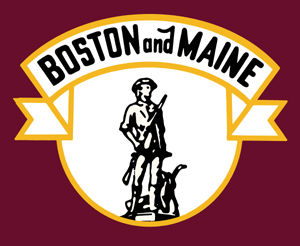
The Boston and Maine Railroad was a U.S. Class I railroad in northern New England. It was chartered in 1835, and became part of what was the Pan Am Railways network in 1983.
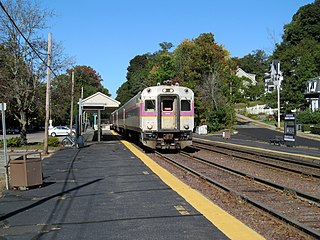
The Haverhill Line is a branch of the MBTA Commuter Rail system, running north from downtown Boston, Massachusetts to Haverhill. The service operates on the Western Route of the former Boston and Maine Railroad, which extends north to Portland, Maine, though MBTA commuter rail service has not continued north of Massachusetts since 1967.
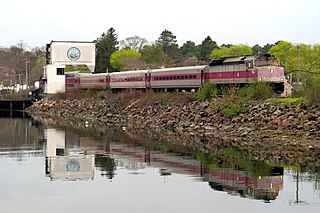
The Newburyport/Rockport Line is a branch of the MBTA Commuter Rail system, running northeast from downtown Boston, Massachusetts towards Cape Ann and the Merrimack Valley, serving the North Shore. The first leg, operating via the Eastern Route of the former Boston and Maine Railroad, serves Chelsea, Lynn, Swampscott, Salem, and Beverly. From there, a northern branch continues via the Eastern Route to serve Hamilton, Ipswich, Rowley, and Newburyport, while other trains operate east from Beverly via the Gloucester Branch, serving Manchester, Gloucester, and Rockport. A bicycle coach is offered on the Rockport branch during the summer. With over 11,000 daily riders in October 2022, the line is the second-busiest on the system.
The Lexington and West Cambridge Railroad was a railroad company chartered in 1845 and opened in 1846 that operated in eastern Massachusetts. It and its successors provided passenger service until 1977 and freight service until 1980 or early 1981.
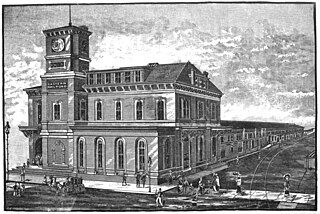
The Eastern Railroad was a railroad connecting Boston, Massachusetts to Portland, Maine. Throughout its history, it competed with the Boston and Maine Railroad for service between the two cities, until the Boston & Maine put an end to the competition by leasing the Eastern in December 1884. Much of the railroad's main line in Massachusetts is used by the MBTA's Newburyport/Rockport commuter rail line, and some unused parts of its right-of-way have been converted to rail trails.

Bradford station is an MBTA Commuter Rail station in the Bradford neighborhood of Haverhill, Massachusetts, served by the Haverhill Line. The Haverhill Line's layover yard is located adjacent to the station. It is temporarily the northern terminal of the Haverhill Line until mid-2025.

Wakefield station is an MBTA Commuter Rail station in Wakefield, Massachusetts served by the Haverhill Line. The station has two side platforms, which are not accessible, serving the line's two tracks. The station building, constructed in 1889, was listed on the National Register of Historic Places in 1989 as Wakefield Upper Depot.

Salem station is an MBTA Commuter Rail station served by the Newburyport/Rockport Line. The station is located off Bridge Street near its interchange with North Street at the north end of downtown Salem, Massachusetts. The station has a single accessible full-length high-level platform serving the single track of the Eastern Route. Just south of the station is the Salem Tunnel, which carries the line under Washington Street. Salem is a major park and ride center, with a 700-space parking garage, as well as an MBTA bus terminal. It is the busiest commuter rail station in the MBTA system outside of the central Boston stations, with an average of 2,326 daily boardings in a 2018 count.

Rockport station is an MBTA Commuter Rail station in Rockport, Massachusetts. It is the terminus of the Rockport branch of the Newburyport/Rockport Line. The station complex consists of a single side platform with one revenue track plus 4 layover tracks for parked trains and a short stretch of auxiliary track.

The Wildcat Branch is a single track railroad branch line which connects the MBTA Lowell Line in Wilmington, Massachusetts to the MBTA Haverhill Line at Wilmington Junction. The total length of the branch line from the connection with the Lowell Line to the merge with the Haverhill Line is 2.88 miles (4.63 km). It was operated from 1836 to 1848, then rebuilt in 1874, and has been used since.

The Salem and Lowell Railroad, chartered in 1848, was a railroad in Massachusetts that connected the towns of Peabody and Tewksbury. The company connected to other railroads at both ends to provide service to its two namesake cities - the Lowell and Lawrence Railroad at Tewksbury Junction, and the Essex Railroad at Peabody. Construction was completed in 1850, with train operations contracted to the Lowell and Lawrence until 1858, when the Boston and Lowell Railroad took over both companies. In 1887, the Boston and Maine Railroad took over the Boston and Lowell and became the new operator of the Salem and Lowell. The line gradually declined in importance from the start of the 20th century, and was progressively abandoned from 1925 onwards. The last trains ran on the route in 1980, and the remainder of the route formally abandoned in 1987. Parts of the right of way are now a rail-trail.
The Lowell and Lawrence Railroad was a small independent railroad that was chartered in 1846 to build a rail line linking the two giant Merrimack River Valley cities of Lowell, Massachusetts to Lawrence, Massachusetts.
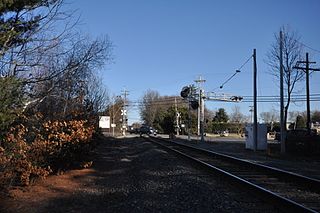
The Lowell and Andover Railroad was a branch line of the Boston and Maine Railroad (B&M) and was organized in 1873, after the Boston and Lowell Railroad (B&L)'s monopoly on Boston to Lowell service ended in 1865. The line opened in 1874 from the B&M's main line at Lowell Junction in Andover, just south of the village of Ballardvale, west to Lowell through Tewksbury.

The Essex Railroad was an American railroad in Essex County, Massachusetts that connected Salem to Lawrence.

The Newburyport Railroad was a railroad that came about from the merger of three small rail companies into one rail line to compete with the Eastern Railroad for service between Newburyport and Boston, Massachusetts. The Newburyport Railroad ran from Newburyport to Wakefield, Massachusetts, where it connected with the Boston and Maine (B&M) for service into Boston.

The Manchester and Lawrence Railroad was a railroad company that was chartered in New Hampshire, United States, by businessmen from Manchester, to build a rail line from that city to the Massachusetts state line.

The Stony Brook Railroad, chartered in 1845, was a railroad company in Massachusetts, United States. The company constructed a rail line between the Nashua and Lowell Railroad's main line at the village of North Chelmsford and the town of Ayer, Massachusetts where it connected to the Fitchburg Railroad. Rather than running its own trains, upon opening in 1848 operations were contracted to the Nashua and Lowell; this arrangement continued until the Nashua and Lowell was leased by the Boston and Lowell Railroad in 1880. The Boston and Maine Railroad (B&M) took over operation of the Stony Brook in 1887 when it leased the Boston and Lowell Railroad. In 1983 the B&M was purchased by Guilford Rail System, which renamed itself Pan Am Railways (PAR) in 2006. Passenger service last ran on the line in 1961, but it saw significant freight service under Pan Am Railways. While it never owned rolling stock or ran trains, the Stony Brook Railroad Corporation existed until 2022 as a nearly wholly owned subsidiary of the Boston and Maine, itself a PAR subsidiary. That year, it was merged into CSX Transportation as part of CSX's purchase of Pan Am Railways.
The Worcester, Nashua and Rochester Railroad was a railroad line that was to link the city of Worcester, Massachusetts, to the city of Portland, Maine, via the New Hampshire cities of Nashua and Rochester, by merging several small shortline railroads together.
The Woburn Branch Railroad was a branch line of the Boston and Lowell Railroad ("B&L") and later of the MBTA Commuter Rail system that connected the Lowell Line with the city square in Woburn, Massachusetts.

The Boston & Northern Street Railway Company (B&N) was a horse-drawn and electric streetcar railroad operated on the streets of Boston, Massachusetts, and communities to the north. Founded in 1859 as the Lynn and Boston Railroad (L&B), via lease and merger it became a primary mass transit provider for northeastern Massachusetts and New Hampshire. Its immediate successor was the Bay State Street Railway (Bay State), and its modern successor is the state-run Massachusetts Bay Transportation Authority (MBTA).



























